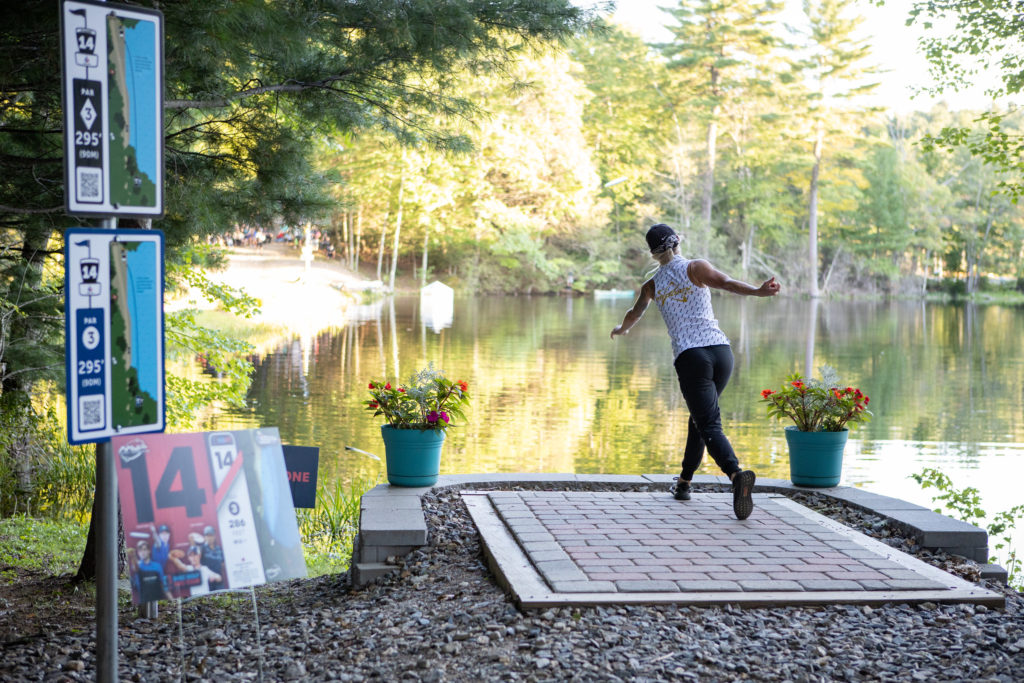Now that you’ve finally figured out how to make the disc fly relatively straight, and your putt’s not a complete embarrassment to the family name, why isn’t your average score going down?
If you’re anything like me, there’s a good chance you haven’t yet learned how to best analyze and attack a hole. After the physical fundamentals, it’s time to begin with the mental basics.
Here’s how to make it happen, Captain:
1. Assess the hole
This tip’s brutally obvious, but that’s exactly why most novice disc golfers either 1) overlook it entirely, or 2) rush through it. Here’s a novel idea: Read the tee sign. They’re there for a reason.
Also, use your eyeballs – look around the fairway.

Before throwing, ask yourself the following:
- Question No. 1 – What’s par?
- Question No. 2 – Where’s the pin?
- Question No. 3 – How far is it to the basket?
- Question No. 4 – What’s the general shape of the hole?
- Question No. 5 – What OB, mandos or obstacles should I be aware of?
Thankfully, all of these questions can be answered by a good tee sign.
* Note: Some tee signs are trash. If yours is lacking, be a bit more observational.
2. Be honest with yourself
It was Sir Winston Leonard Spencer Churchill who once said, “Men occasionally stumble over the truth, but most of them pick themselves up and hurry off as if nothing had happened.”
Force yourself to “stumble” over your ACTUAL skill level – don’t run away, though …
You’ll improve, but for now, embrace where you’re at – you’ll be better off for it.

More questions:
- Question No. 6 – Do you realistically have the distance?
- Question No. 7 – Can you throw the disc the way you intend to?
- Question No. 8 – Are you capable of birdieing the hole? Or, will par suffice?
Even in disc golf, honesty is the best policy.
As such, I have a confession to make …
Throughout the course of my disc golf career, I have gone for 16 island holes in tournament play. Each time, I could’ve laid up short and pitched up to the green for an easy par. Out of those 16 attempts, I made it safely onto the intended island TWICE. Without fail, after each of those 14 OB tosses, I kicked myself for not playing for par like someone with a functioning brain …
Don’t let pride cost you strokes – or even worse, a disc.
3. Focus on where you want the disc to land
Everybody wants an ace, but how often do you go all-out for one off the tee and walk away with a bogey or worse? Until you can stick the disc close with a spike-hyzer or make comeback putts with real confidence, avoid extra, round-ruining strokes by opting for a landing zone.

If you can drive the hole, more power to you – aim for the green and hope for the best. But if your ability only allows you to reach the fairway, that’s fine, too. Pick a nice, open spot where you’ll be able to reach the pin with a simple, unobstructed approach on your second shot …
Don’t be stupid; play for position.
4. Go with your gut (and don’t second-guess it)
Once you’ve analyzed a hole and formulated a plan of attack, stick with it. When you take a multiple choice test, you go with your first choice, unless new information presents itself.
For example, out on the course, the equivalent of “new information” might be an unexpected wind read from a player on your card teeing off before you. Don’t go crazy with this, though …

One of your playing partners parking a tough hole with a putter that you were planning on laying up on with a fairway driver isn’t necessarily “new information.” I can’t stress this enough …
NOBODY knows your game better than you: Go with your gut.
5. Give yourself permission to make mistakes
This last tip isn’t so much about how to attack the hole you’re currently on, but the thousands that’ll come after it: If your game’s going to improve, you’ve got to experiment with stuff …
This means enduring a crap-ton of terrible shots.
Give yourself permission to make mistakes. Instead of throwing a hissy-fit after an errant drive, upshot or putt, laugh it off, remember how much you suck and thank your lucky stars you’ve got a nine-to-five gig. This is amateur disc golf. In spite of your poor play, life will continue ….
Fingers crossed.
As with most things, these tips are easier said than done. You’ll have to practice them repeatedly for them to become automatic, but it’ll happen. Be patient: Improvement is well on its way.
Have anything to add? Take to Twitter to let us know – we’ll actually (for real) get back to you.
Editor’s Suggestions:
- 4 reasons Paul McBeth is disc golf’s premier villain
- Opinion: Less Disc Golf Valley, more actual disc golf
- Disc golf: What’s a thumbtrack? (and why you’ll want one)
Real quick, if you happen to buy something through a link in this article, there’s a chance we’ll get a small share of the sale. It’s how we keep the lights on. To learn more, click here.

Its a great alternative when you can get to the course & a fun way to get you fix in when you cant leave work when all your friends get out during the daylight hours. Very frustrating yet quite the challenge.
Couldn’t agree more, Mike!
Thanks for reading, as well as chiming in 🙂